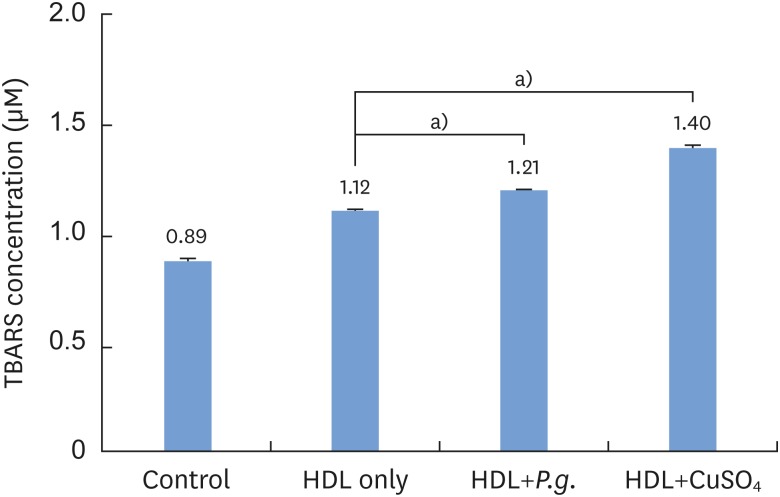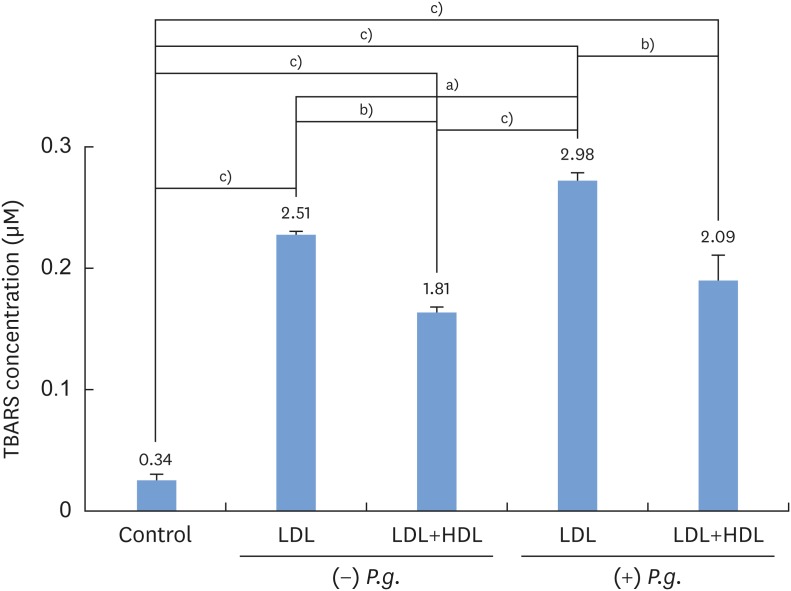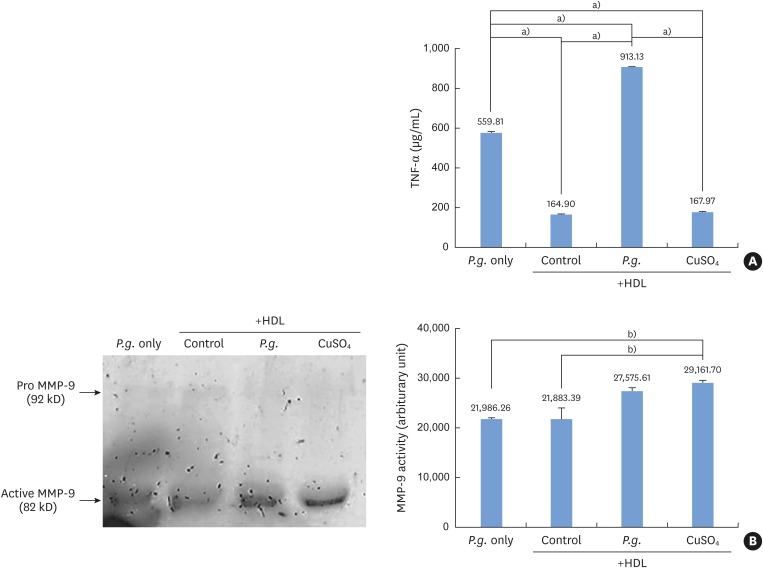1. Genco R, Offenbacher S, Beck J. Periodontal disease and cardiovascular disease: epidemiology and possible mechanisms. J Am Dent Assoc. 2002; 133:14S–22S. PMID:
12085720.
2. Koizumi Y, Kurita-Ochiai T, Oguchi S, Yamamoto M. Nasal immunization with
Porphyromonas gingivalis outer membrane protein decreases
P. gingivalis-induced atherosclerosis and inflammation in spontaneously hyperlipidemic mice. Infect Immun. 2008; 76:2958–2965. PMID:
18426881.
3. Muhlestein JB, Anderson JL, Hammond EH, Zhao L, Trehan S, Schwobe EP, et al. Infection with
Chlamydia pneumoniae accelerates the development of atherosclerosis and treatment with azithromycin prevents it in a rabbit model. Circulation. 1998; 97:633–636. PMID:
9495296.
4. Lösche W, Karapetow F, Pohl A, Pohl C, Kocher T. Plasma lipid and blood glucose levels in patients with destructive periodontal disease. J Clin Periodontol. 2000; 27:537–541. PMID:
10959778.

5. Laurila A, Bloigu A, Näyhä S, Hassi J, Leinonen M, Saikku P. Chronic
Chlamydia pneumoniae infection is associated with a serum lipid profile known to be a risk factor for atherosclerosis. Arterioscler Thromb Vasc Biol. 1997; 17:2910–2913. PMID:
9409275.
6. Laurila A, Bloigu A, Näyhä S, Hassi J, Leinonen M, Saikku P. Association of
Helicobacter pylori infection with elevated serum lipids. Atherosclerosis. 1999; 142:207–210. PMID:
9920523.
7. Pussinen PJ, Jauhiainen M, Vilkuna-Rautiainen T, Sundvall J, Vesanen M, Mattila K, et al. Periodontitis decreases the antiatherogenic potency of high density lipoprotein. J Lipid Res. 2004; 45:139–147. PMID:
13130123.

8. Steinberg D. Low density lipoprotein oxidation and its pathobiological significance. J Biol Chem. 1997; 272:20963–20966. PMID:
9261091.

9. Mertens A, Holvoet P. Oxidized LDL and HDL: antagonists in atherothrombosis. FASEB J. 2001; 15:2073–2084. PMID:
11641234.

10. Rosenson RS, Brewer HB Jr, Ansell BJ, Barter P, Chapman MJ, Heinecke JW, et al. Dysfunctional HDL and atherosclerotic cardiovascular disease. Nat Rev Cardiol. 2016; 13:48–60. PMID:
26323267.

11. Khovidhunkit W, Shigenaga JK, Moser AH, Feingold KR, Grunfeld C. Cholesterol efflux by acute-phase high density lipoprotein: role of lecithin:cholesterol acyltransferase. J Lipid Res. 2001; 42:967–975. PMID:
11369805.

12. Kameda T, Ohkawa R, Yano K, Usami Y, Miyazaki A, Matsuda K, et al. Effects of myeloperoxidase-induced oxidation on antiatherogenic functions of high-density lipoprotein. J Lipids. 2015; 2015:592594. PMID:
26257958.

13. Florentin M, Liberopoulos EN, Wierzbicki AS, Mikhailidis DP. Multiple actions of high-density lipoprotein. Curr Opin Cardiol. 2008; 23:370–378. PMID:
18520722.

14. Francis GA. High density lipoprotein oxidation:
in vitro susceptibility and potential
in vivo consequences. Biochim Biophys Acta. 2000; 1483:217–235. PMID:
10634938.
15. Barter PJ, Baker PW, Rye KA. Effect of high-density lipoproteins on the expression of adhesion molecules in endothelial cells. Curr Opin Lipidol. 2002; 13:285–288. PMID:
12045398.

16. Maekawa T, Takahashi N, Tabeta K, Aoki Y, Miyashita H, Miyauchi S, et al. Chronic oral infection with
Porphyromonas gingivalis accelerates atheroma formation by shifting the lipid profile. PLoS One. 2011; 6:e20240. PMID:
21625524.
17. Miyakawa H, Honma K, Qi M, Kuramitsu HK. Interaction of
Porphyromonas gingivalis with low-density lipoproteins: implications for a role for periodontitis in atherosclerosis. J Periodontal Res. 2004; 39:1–9. PMID:
14687221.
18. Joo JY, Cha GS, Chung J, Lee JY, Kim SJ, Choi J. Peptide 19 of
Porphyromonas gingivalis heat shock protein is a potent inducer of low-density lipoprotein oxidation. J Periodontol. 2017; 88:e58–e64. PMID:
27712463.
19. Soumyarani VS, Jayakumari N. Oxidized HDL induces cytotoxic effects: implications for atherogenic mechanism. J Biochem Mol Toxicol. 2014; 28:481–489. PMID:
25044446.

20. Soumyarani VS, Jayakumari N. Oxidatively modified high density lipoprotein promotes inflammatory response in human monocytes-macrophages by enhanced production of ROS, TNF-α, MMP-9, and MMP-2. Mol Cell Biochem. 2012; 366:277–285. PMID:
22527933.

21. Persson J, Nilsson J, Lindholm MW. Interleukin-1beta and tumour necrosis factor-alpha impede neutral lipid turnover in macrophage-derived foam cells. BMC Immunol. 2008; 9:70. PMID:
19032770.

22. Jones CB, Sane DC, Herrington DM. Matrix metalloproteinases: a review of their structure and role in acute coronary syndrome. Cardiovasc Res. 2003; 59:812–823. PMID:
14553821.

23. Gough PJ, Gomez IG, Wille PT, Raines EW. Macrophage expression of active MMP-9 induces acute plaque disruption in apoE-deficient mice. J Clin Invest. 2006; 116:59–69. PMID:
16374516.

24. Ren J, Jin W, Chen H. oxHDL decreases the expression of CD36 on human macrophages through PPARgamma and p38 MAP kinase dependent mechanisms. Mol Cell Biochem. 2010; 342:171–181. PMID:
20458524.
25. Nakajima T, Origuchi N, Matsunaga T, Kawai S, Hokari S, Nakamura H, et al. Localization of oxidized HDL in atheromatous plaques and oxidized HDL binding sites on human aortic endothelial cells. Ann Clin Biochem. 2000; 37:179–186. PMID:
10735361.








 PDF
PDF ePub
ePub Citation
Citation Print
Print




 XML Download
XML Download